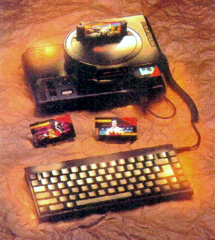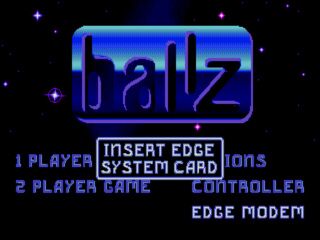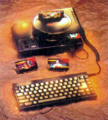Difference between revisions of "Edge 16"
From Sega Retro
m (Text replacement - "{{fileref\|CVG UK (1[0-9][0-9])\.pdf\|page=(.*)}}" to "{{magref|cvg|$1|$2}}") |
m |
||
| (26 intermediate revisions by 4 users not shown) | |||
| Line 1: | Line 1: | ||
{{AccessoryBob | {{AccessoryBob | ||
| − | | accessoryimage=Edge16 | + | | accessoryimage=Edge16 alt.png |
| − | + | | accessoryprogramscreen=Ballz3D Edge16 systemcardrequest.jpg | |
| − | | accessoryprogramscreen= | ||
| title= | | title= | ||
| maker=[[PF Magic]], [[AT&T]] | | maker=[[PF Magic]], [[AT&T]] | ||
| + | | type=Network tool | ||
| madefor=[[Sega Mega Drive]] | | madefor=[[Sega Mega Drive]] | ||
}} | }} | ||
| − | The ''' | + | {{stub}}The '''{{PAGENAME}}''' is an unreleased [[Sega Genesis]] modem created as a joint venture between [[PF Magic]] and [[AT&T]]. |
| − | The Edge 16 was a device to be inserted into the cartridge slot of a Mega Drive console, allowing two players to compete with Mega Drive games through the internet - control pad signals would be sent through the phone line, as would sounds from a microphone to allow players to communicate. A card slot at the front of the device would have been used to save game data to memory cards.{{magref|cvg|141|20}} | + | ==Hardware== |
| + | [[File:Ballz3D Edge16 systemcardrequest.jpg|thumb|280px|[[PF Magic]]'s ''[[Ballz 3D]]'' still retains support for the unreleased modem.]] | ||
| + | The Edge 16 was a device to be inserted into the cartridge slot of a Mega Drive console, allowing two players to compete with Mega Drive games through the internet - control pad signals would be sent through the phone line, as would sounds from a microphone to allow players to communicate. A card slot at the front of the device would have been used to save game data to memory cards.{{magref|cvg|141|20}} A keyboard attachment was also shown, though few details are known about it. | ||
| − | + | ==Games== | |
| + | While very few games were specifically announced to support the Edge 16, two titles were confirmed to have planned support for the modem: [[PF Magic]]'s own ''[[Ballz 3D: The Battle of the Balls]]'', and [[GameTek]]'s ''[[Brutal: Paws of Fury]]''.{{magref|mega|18|9}} Notably, in the case of the former, the game still retains code for the Edge 16, and would presumably work as intended when provided the corresponding hardware. | ||
| − | The | + | [[Dynamix]], [[Electronic Arts]], [[Gametek]], [[Acclaim]], and [[Sega]] were all reportedly interested in developing for the hardware.{{magref|egm2|4|37}}{{magref|sfus|1994-07|14}} |
| + | |||
| + | ===List of games with planned support=== | ||
| + | *''[[Ballz 3D: The Battle of the Balls]]'' (1994) | ||
| + | *''[[Brutal: Paws of Fury]]'' (1994) | ||
| + | *''[[The Shadow of Yserbius]]'' (unreleased) | ||
| + | |||
| + | ==History== | ||
| + | Announced in July 1993 at [[Summer CES 1993]], the Edge 16 was initially scheduled for a summer 1994 launch in the United States, with software support from developers [[Electronic Arts]], [[Tengen]], [[GameTek]] and [[Microprose]].{{magref|videogamesus|56|18}} It made its first appearance in January 1994 at [[Winter CES 1994]], where attendees could play matches of ''[[Ballz 3D]]'' across the booth via two Edge 16 units. While appearing promising in the gaming press, this would be the system's one and only appearance. | ||
| + | |||
| + | Reportedly, the Edge 16 was fully completed and ready to ship by September 1994, but [[AT&T]] changed its mind about entering the video game industry in the autumn of 1994{{magref|gameplayers|0711|14}}, and the hardware was ultimately left unreleased. An AT&T spokesperson commented that "the company chose to devote attention to developing new telephone technologies", but that the possibility of selling the Edge 16 to a third-party wasn't out of the question.{{magref|gamepro|64|284}} The limited lifespan of the [[Mega Drive]] as the industry moved to 32-bit and 64-bit consoles was cited as an additional reason for its cancellation.{{magref|gameplayers|0711|14}} Had it actually made it to store shelves, it would have been priced between $100 and $150 USD.{{magref|edge|1|15}} | ||
==Magazine articles== | ==Magazine articles== | ||
| Line 21: | Line 34: | ||
<gallery> | <gallery> | ||
Edge16 MD US PrintAdvert.jpg|US print advert | Edge16 MD US PrintAdvert.jpg|US print advert | ||
| + | </gallery> | ||
| + | |||
| + | ==Photo gallery== | ||
| + | <gallery> | ||
| + | Edge16 alt.png|Promotional photograph from Summer CES 1993. | ||
| + | Edge16 MD.jpg|Promotional photograph from Summer CES 1993. | ||
| + | Edge16 play.png|A promotional photograph of an unknown game being played. | ||
| + | Edge16 2.png|A modern photograph of a unit owned by a collector. | ||
| + | Edge16 3.png|A modern photograph of a unit owned by a collector. | ||
| + | Edge16 4.png|A modern photograph of a unit owned by a collector. | ||
</gallery> | </gallery> | ||
==References== | ==References== | ||
| − | <references /> | + | <references/> |
| − | |||
{{MegaDrive}} | {{MegaDrive}} | ||
| − | |||
[[Category:Unreleased Mega Drive accessories]] | [[Category:Unreleased Mega Drive accessories]] | ||
| + | [[Category:Online services]] | ||
Latest revision as of 20:19, 3 September 2024
| Edge 16 |
|---|
| Made for: Sega Mega Drive |
| Manufacturer: PF Magic, AT&T |
| Type: Network tool |
This short article is in need of work. You can help Sega Retro by adding to it.
The Edge 16 is an unreleased Sega Genesis modem created as a joint venture between PF Magic and AT&T.
Contents
Hardware
The Edge 16 was a device to be inserted into the cartridge slot of a Mega Drive console, allowing two players to compete with Mega Drive games through the internet - control pad signals would be sent through the phone line, as would sounds from a microphone to allow players to communicate. A card slot at the front of the device would have been used to save game data to memory cards.[1] A keyboard attachment was also shown, though few details are known about it.
Games
While very few games were specifically announced to support the Edge 16, two titles were confirmed to have planned support for the modem: PF Magic's own Ballz 3D: The Battle of the Balls, and GameTek's Brutal: Paws of Fury.[2] Notably, in the case of the former, the game still retains code for the Edge 16, and would presumably work as intended when provided the corresponding hardware.
Dynamix, Electronic Arts, Gametek, Acclaim, and Sega were all reportedly interested in developing for the hardware.[3][4]
List of games with planned support
- Ballz 3D: The Battle of the Balls (1994)
- Brutal: Paws of Fury (1994)
- The Shadow of Yserbius (unreleased)
History
Announced in July 1993 at Summer CES 1993, the Edge 16 was initially scheduled for a summer 1994 launch in the United States, with software support from developers Electronic Arts, Tengen, GameTek and Microprose.[5] It made its first appearance in January 1994 at Winter CES 1994, where attendees could play matches of Ballz 3D across the booth via two Edge 16 units. While appearing promising in the gaming press, this would be the system's one and only appearance.
Reportedly, the Edge 16 was fully completed and ready to ship by September 1994, but AT&T changed its mind about entering the video game industry in the autumn of 1994[6], and the hardware was ultimately left unreleased. An AT&T spokesperson commented that "the company chose to devote attention to developing new telephone technologies", but that the possibility of selling the Edge 16 to a third-party wasn't out of the question.[7] The limited lifespan of the Mega Drive as the industry moved to 32-bit and 64-bit consoles was cited as an additional reason for its cancellation.[6] Had it actually made it to store shelves, it would have been priced between $100 and $150 USD.[8]
Magazine articles
- Main article: Edge 16/Magazine articles.
Promotional material
Photo gallery
References
- ↑ Computer & Video Games, "August 1993" (UK; 1993-07-15), page 20
- ↑ Mega, "March 1994" (UK; 1994-02-17), page 9
- ↑ EGM², "October 1994" (US; 1994-xx-xx), page 37
- ↑ Sega Force, "Summer 1994" (US; 1994-xx-xx), page 14
- ↑ VideoGames, "September 1993" (US; 1993-0x-xx), page 18
- ↑ 6.0 6.1 Game Players, "Vol. 7 No. 11 November 1994" (US; 1994-1x-xx), page 14
- ↑ GamePro, "November 1994" (US; 1994-xx-xx), page 284
- ↑ Edge, "October 1993" (UK; 1993-08-19), page 15









